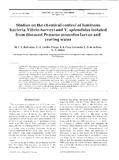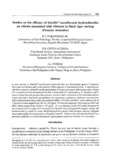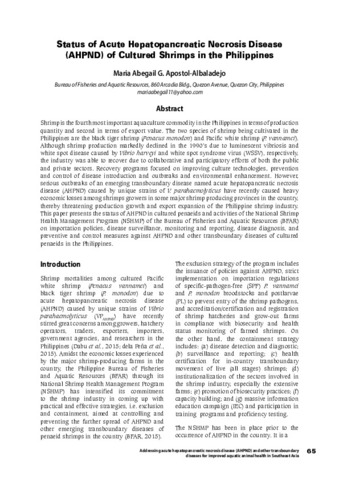Studies on the chemical control of luminous bacteria Vibrio harveyi and V. splendidus isolated from diseased Penaeus monodon larvae and rearing water
- Global styles
- MLA
- Vancouver
- Elsevier - Harvard
- APA
- Help

View/Open
Date
1990Author
Page views
2,942ASFA keyword
AGROVOC keyword
Taxonomic term
Metadata
Show full item recordCited times in Scopus
77 readers on Mendeley
- Citations
- CrossRef - Citation Indexes: 79
- Policy Citation - Policy Citations: 1
- Captures
- Mendeley - Readers: 78
Share
Abstract
The minimum inhibitory concentrations (MICs) and minimum bactericidal concentrations (MBCs) of 24 drugs for luminous bacteria Vibrio harveyi and V. splendidus were determined. Only chloramphenicol, sodium nifurstyrenate and the nitrofurans (furazolidone, nitrofurazone, nitrofurantoin and Prefuran) showed relatively low MICs and MBCs (<25 µg/ml-1). The bacteria showed varied responses to chloramphenicol and Prefuran and low sensitivity to oxytetracycline. Chloramphenicol, oxytetracycline and Prefuran are commonly used in shrimp hatcheries. Shrimp larvae showed high survival rates and active swimming movement after 24 h exposure to in vivo bactericidal doses of chloramphenicol, Furacin, nitrofurantoin (protozoa only), oxytetracycline (nauplius only), Prefuran (mysis only) and sodium nifurstyrenate, but the drugs caused deformities in the carapace, rostrum, and setae. Chemical control of luminous vibriosis among shrimp larvae appears limited, based on the efficacy of existing and readily available drugs, because of the possible development of resistant strains of bacteria and the limited tolerance of the shrimp larvae to the drugs.
Suggested Citation
Baticados, M. C. L., Lavilla-Pitogo, C. R., Cruz-Lacierda, E. R., de la Peña, L. D., & Suñaz, N. A. (1990). Studies on the chemical control of luminous bacteria Vibrio harveyi and V. splendidus isolated from diseased Penaeus monodon larvae and rearing water. Diseases of Aquatic Organisms , 9(2), 133-139. https://doi.org/10.3354/dao009133
Type
ArticleISSN
0177-5103Collections
- Journal Articles [1249]
Related items
Showing items related by title, author, creator and subject.
-
Studies on the efficacy of Sarafin® (sarafloxacin hydrochloride) on vibrios associated with vibriosis in black tiger shrimp (Penaeus monodon)
Pakingking, Rolando V., Jr. ; Lacierda, Erlinda; Torres, James L. (Fish Health Section, Asian Fisheries Society, 2002)
In vitro activity of Sarafin® (sarafloxacin hydrochloride) was determined against 7 luminous Vibrio harveyi isolates and 3 non-luminous Vibrio species (V. parahaemolyticus, V. alginolyticus and Vibrio species) isolated ...
; Lacierda, Erlinda; Torres, James L. (Fish Health Section, Asian Fisheries Society, 2002)
In vitro activity of Sarafin® (sarafloxacin hydrochloride) was determined against 7 luminous Vibrio harveyi isolates and 3 non-luminous Vibrio species (V. parahaemolyticus, V. alginolyticus and Vibrio species) isolated ... -
Current status of shrimp farming and diseases in Cambodia
Lang, Ouch; Sothea, Mey (Aquaculture Department, Southeast Asian Fisheries Development Center, 2016)The farming of penaeid shrimps in Cambodia began in 1989 and has significantly expanded since 1991. Shrimp cultivation has been carried out in the four coastal provinces, i.e. Kampot, Kep, Preah Sihanouk Ville, and Koh ... -
Status of acute hepatopancreatic necrosis disease (AHPND) of cultured shrimps in the Philippines
Apostol-Albaladejo, Maria Abegail G. (Aquaculture Department, Southeast Asian Fisheries Development Center, 2016)Shrimp is the fourth most important aquaculture commodity in the Philippines in terms of production quantity and second in terms of export value. The two species of shrimp being cultivated in the Philippines are the black ...






